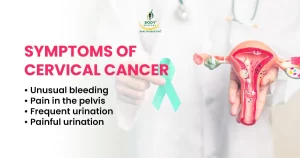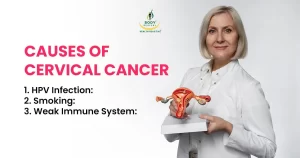Cervical cancer affects many women globally, but it can often be prevented. It starts in the cervix and is mainly caused by certain things and a human papillomavirus (HPV).
The cervix is the lower part of the uterus and connects it to the vagina. Cervical cancer occurs when the cells in the cervix change. It can affect the deeper tissues of the cervix and spread to other parts of the body. All women are at risk of cervical cancer, but women over the age of 30 are at most risk.
Cancer cells in the cervix are abnormal cells that shouldn’t be there. Tests like Pap smears or HPV tests help find these cells early for better treatment.
Symptoms of Cervical Cancer
- Unusual bleeding
- Pain in the pelvis
- Frequent urination
- Painful urination
- Unusual vaginal discharge
- Painful intercourse
- Heavier and longer menstrual bleeding than usual
- Bleeding post menopause
You must talk to your doctor if you bleed after menopause, have extreme bleeding during or between your periods, and have bleeding after intercourse often.
Causes of Cervical Cancer
Three main things can cause cervical cancer:

- HPV Infection: This virus, especially types like HPV 16 and HPV 18, can cause cervical cancer if it stays in the body for a long time.
- Smoking: If you smoke, chemicals in cigarettes can make it easier for cervical cells to get infected with HPV, which can lead to cancer.
- Weak Immune System: If your immune system is not strong due to certain illnesses or medicines, it might make it easier for HPV to cause cervical cancer.
HPV, a sexually transmitted infection, causes most cervical cancer cases. However, vaccines can easily prevent HPV infection. Cervical cancer grows slowly, which makes it relatively easier to treat before it causes more serious problems.
Since cervical cancer is slow to spread, it might not show any symptoms in the earlier stages at all. So, to rule out the possibility of cervical cancer, women should get regular Pap tests.
Types of Cervical Cancer
- Squamous Cell Carcinoma: This starts in the flat cells on the outer part of the cervix.
- Adenocarcinoma: It begins in the epithelial cells lining the cervical canal.
Cervical Cancer Prevention
Preventing cervical cancer involves getting regular check-ups, like Pap smears and HPV tests, to catch any problems early. Getting vaccinated against HPV can significantly reduce the likelihood of developing cervical cancer. To safeguard yourself against cervical cancer, you can take the following preventive measures:
- Get pap tests every three years – Get pap tests done every three years once you’re 21 or older to rule out the possibility of cervical cancer.
- Get regular tests done for Chlamydia, gonorrhoea, and syphilis if you’re sexually active.
- Practice safe sex – Practicing safe sex is essential to reduce the risk of HPV infection, which is a leading cause of cervical cancer.
- Get HPV vaccination done – Immunising beforehand stands as a precautionary measure since 70% of cervical cancers result from HPV infection.
- Quit smoking – The use of tobacco can damage the DNA of cervix cells and can lead to the development of cervical cancer.
Immunotherapy for Cervical Cancer
Immunotherapy is a new way to treat cervical cancer. It uses the body’s immune system to fight and kill cancer cells. Researchers are testing treatments like immune checkpoint inhibitors to improve cervical cancer treatment.
To beat cervical cancer, it’s important to understand what causes it, the different types, and how we can stop it. Early check-ups and screenings are crucial. New treatments like immunotherapy give hope for better outcomes for those fighting this disease.



























